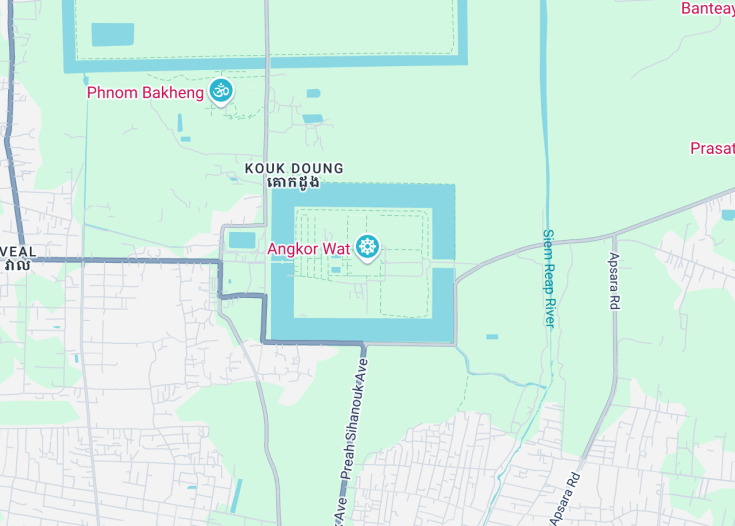Angkor Wat, nestled in the heart of Cambodia, stands as a monumental testament to the grandeur of Khmer architecture. Originally constructed in the early 12th century as a Hindu temple dedicated to the god Vishnu, it gradually transformed into a Buddhist temple. This UNESCO World Heritage site, acclaimed for being the world’s largest religious monument, spans over 162 hectares. Its intricate carvings, majestic towers, and vast moats draw scholars and tourists alike, making it an emblem of Cambodia’s rich cultural and spiritual tapestry.
Visit during the early morning to witness the breathtaking sunrise behind Angkor Wat’s iconic silhouette, providing a magical and less crowded experience.
Consider hiring a knowledgeable local guide to enhance your visit, as they can offer insightful stories and historical context that enrich the exploration of this ancient site.
Angkor Wat: A Marvel of Ancient Architecture
Angkor Wat, located in Cambodia, stands as a majestic symbol of the country’s heart and soul. Initially constructed in the early 12th century, the temple complex was first intended to honor the Hindu god Vishnu. Over time, it gracefully transitioned into a Buddhist temple, showcasing the dynamic spiritual history of the region. Spanning over 162 hectares, it is the largest religious monument in the world and forms a significant part of the Angkor World Heritage Site. Its architectural grandeur and intricate bas-reliefs narrate the tales of mythology and history, drawing millions of tourists each year. The temple’s unique structure, characterized by its pointed towers and concentric galleries, is recognized as a symbol of Cambodia, appearing even in the national flag. The best times to visit are during sunrise or sunset, when the soft light magnifies its beauty, creating a breathtaking scene. As a UNESCO World Heritage site, Angkor Wat not only serves as a powerhouse of cultural heritage but also stands as a testament to the ingenuity of the Khmer Empire.
Exploring the Mystique of Angkor Wat
Angkor Wat offers a plethora of visually stunning and historically rich experiences for its visitors. The temple complex is known for its grandeur and the extensive bas-relief frescoes that depict stories from Hindu mythology, including the famous Churning of the Ocean of Milk. Each tower within the complex represents Mount Meru, a sacred mountain in Hindu, Jain, and Buddhist cosmology, thought to be the center of all physical, metaphysical, and spiritual universes. Guided tours are highly recommended as they offer insightful narratives about the site’s history and significance. Additionally, visitors often partake in photography tours due to the site’s overwhelming aesthetic appeal. For the more adventurous, hot air balloon rides provide stunning aerial views of the complex and surrounding landscape.
The Enigmatic Bayon Temple
Within the Angkor complex, the Bayon stands out for its distinctive architectural style, different from Angkor Wat. Marked by its serene and massive stone faces on the many towers, which jut out from the upper terrace and cluster around its central peak, the temple is considered the magnum opus of Khmer architecture. Bayon’s most distinctive feature is the multitude of serene and smiling stone faces on the many towers which project from the upper terrace and cluster around its central peak, making it a photographer’s paradise. The temple portrays the baroque style of Khmer architecture, contrary to the classical style of Angkor Wat. Every intricate detail here narrates a story, providing a window into the soul of the ancient Khmer empire.
Explore the Majestic Angkor Wat
Angkor Wat is perfect for history enthusiasts, spiritual seekers, and architectural aficionados. It offers a complex of temples that stand not only as a key religious site but also as a symbol of Cambodia’s heart and soul. Visitors can expect a transformative experience, immersed in the immense historical significance and stunning beauty of the site’s ancient structures.
Discover the Ideal Time to Visit Angkor Wat
The best times to explore Angkor Wat are during the cooler, drier months from November to February, when the weather is more comfortable for outdoor activities. Avoid the rainy season from June to October, as frequent downpours may impede exploration of the complex.
Annual Events to Consider
The Angkor Wat International Half Marathon in December is a wonderful opportunity for visitors who can witness an international event in a historical setting.
Accessibility and Limitations at Angkor Wat
Understanding the accessibility and limitations at Angkor Wat enhances the visit.
Accessibility
Limitations
- Dress Code: Modest clothing is required – shoulders and knees must be covered.
- Age: There are no age restrictions, making it ideal for visitors of all ages.
- Physical Characteristics: Some areas may not be accessible for those with mobility issues.
- Alcohol: Alcohol consumption is not permitted on the premises.
Notes to visitors
- Health risks: Be prepared for intense heat; stay hydrated.
- Physical effort: Significant walking and climbing are required to explore fully.
- Language barrier: Tour guides available in multiple languages.
- Requested behavior: Respect the cultural and sacred nature of the site.
General Information
Plan your visit to ensure a memorable experience at Angkor Wat.
Location
Near the Siem Reap River, a short drive from Siem Reap city center.
Address:
Krong Siem Reap, Siem Reap Province, Cambodia
Opening Hours
Angkor Wat is open daily from 5:00 AM to 6:00 PM, including holidays.
How to Reach Angkor Wat
Reaching Angkor Wat from nearby cities is straightforward with multiple transportation options.
Car
Most visitors prefer to drive or hire a taxi.
| Route | Distance | Travel time |
|---|---|---|
| From Phnom Penh | 143 miles (230 km) | Approx. 5 hours |
| From Battambang | 104 miles (167 km) | Approx. 3 hours |
Bus
Buses are available from major cities like Phnom Penh and offer a cost-effective way to reach Siem Reap.
Nearby Attractions
Explore other sights around Angkor Wat:
- Bayon Temple – 1.5 miles (2.4 km)
- Ta Prohm – 1 mile (1.6 km)
- Angkor Thom – 1.2 miles (1.9 km)
- Preah Khan – 4 miles (6.4 km)
- Banteay Srei – 15 miles (24 km)
- Beng Mealea – 25 miles (40 km)
Common Questions
What is the best time of year to visit Angkor Wat?
What should I wear when visiting Angkor Wat?
Are there any cultural etiquette tips I should follow while visiting Angkor Wat?
Can I take photographs inside Angkor Wat?
What are the must-see parts of Angkor Wat?
Is there a code of conduct for visiting Angkor Wat?
Are there any health considerations I should be aware of when visiting Angkor Wat?
What archaeological significance does Angkor Wat hold?
How should I prepare for a day trip to Angkor Wat?
What is the historical significance of Angkor Wat?
What conservation efforts are in place for Angkor Wat?
What nearby attractions should I consider visiting after Angkor Wat?

Is Angkor Wat in Krong Siem Reap worth visiting?
Angkor Wat stands as a monument of historical and architectural significance, attracting millions of tourists each year. This iconic temple complex, originally constructed in the 12th century during the Khmer Empire, provides a unique glimpse into an ancient civilization’s spirituality and ingenuity. Visiting Angkor Wat offers not only stunning visuals and intricate carvings but also a deep insight into the cultural heritage of Cambodia. Despite potential issues with overcrowding, adequate planning can mitigate those setbacks, making a trip here highly rewarding. Moreover, its status as a UNESCO World Heritage site validates its global importance and the ongoing efforts to preserve its structure and appeal for future generations. In conclusion, Angkor Wat’s profound legacy and breathtaking scenery indeed make it worth visiting for those fascinated by history and architecture.










